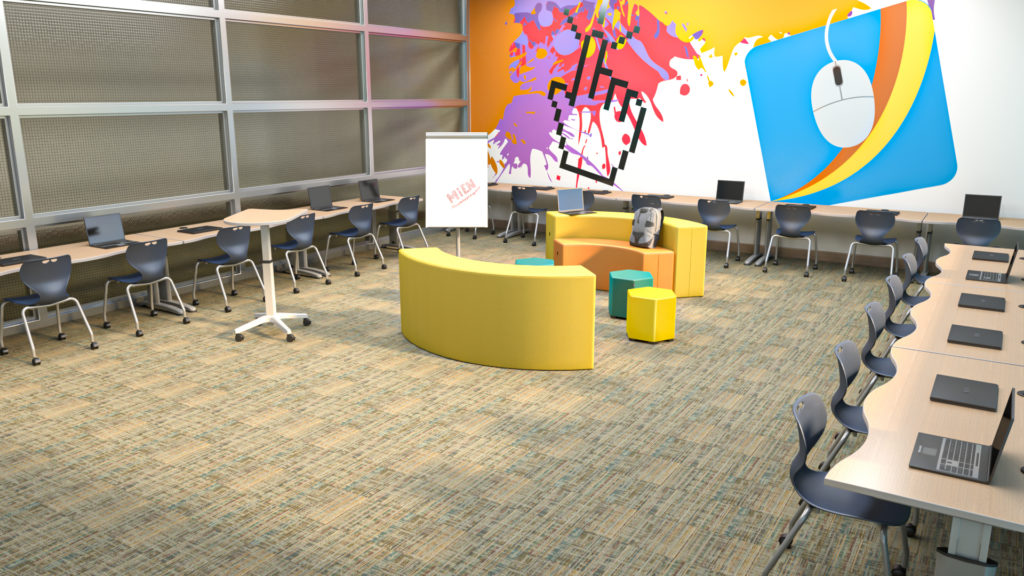The prevalence of personal devices in the classroom has resulted in the computer labs of the past losing much of their value as spaces for digital and online learning. Laptops and tablets have made it possible for students to take digital learning anywhere — both in and out of the classroom — without being confined to a hard-wired desktop in a computer lab.
Today, computer labs have a new function as learning spaces. A modern computer lab serves as a home for collaboration, STEM programs, makerspaces, and Esports — just to name a few. With a change in the function of computer labs, learning space design in computer labs has had to change as well. The focus is becoming more about collaboration and creativity, which is aligned to what students will encounter in college and the workplace!
Computer labs of the past often only offered surface space for each desktop computer — of which there were at least enough to fit a whole class with one student at each monitor. In a modern computer lab, it is crucial to offer tabletop space that isn’t occupied by a desktop and keyboard. Configurable desks and tables can create spaces for small group collaboration and brainstorming or spaces for individual work areas.

Flexible Furniture
Integrating soft seating into the modern computer lab creates a comfortable environment that promotes social interaction. Keeping the soft seating, desks, tables, and chairs on casters for mobility allows for furniture to easily be reconfigured as virtual reality and other tech innovations enter the curriculum.
Mobile Whiteboards, whiteboard tabletops, or writable surfaces installed (such as glass windows or walls) on multiple walls provide space for mini-lectures, brainstorming, and visual thinking.
With flexible furniture pieces, a computer lab can function as a responsive learning space that can accommodate several different subjects and activities. The right modular and movable tables and seating allow for collaboration, discussion and instruction, and space for students to use their personal devices.

Open Space
Computer labs of the past have been characterized by rows or a circle of desks with hard-wired desktop computers at every seat. With the prevalence of personal devices, a modern computer lab has to be able to accommodate students who bring their own laptop or tablet, and this means leaving open space where students can set up their own devices and learning materials.
Furthermore, it is essential to provide accessible power sources that do not interfere with the stationary computers and technology in the room. Particularly with technology that has higher processing power, a complex startup process, or programmed settings that reset after power loss, you don’t want to risk students unplugging anything to use outlets for their own devices.
STEM and Esports
One of the most global qualities of a modern computer lab is that it does not act solely as a computer lab. Other than being a space for collaboration and offering areas for personal device usage, a modern computer lab can work in tandem with a makerspace or an Esports arena.
Offering a makerspace in a shared area with a computer lab gives students the ability to research their maker activities or use computer programs to further explore topics such as coding and robotics. Multi-purpose workstations and storage solutions give students a dedicated space to learn and discover STEM topics separately from computer stations in a lab.
Just a few important changes to furniture and classroom design are all it takes to refresh an outdated computer lab into a future-ready computer lab, makerspace, or Esports arena of the future.
With the right hardware and software, computer labs can be transformed into Esports labs as well. For students who spend hours practicing and competing in front of large screens at stationary desks, it’s necessary to implement comfortable seating for mandated screen breaks. Rolling chairs, balancing stools, and adjustable height seating can also keep students moving as they spend time practicing their games.
Rebrand
In a modern computer lab, flexibility of function allows students of all ages to thrive and work in a way that complements their learning style. Just a few important changes to furniture and classroom design are all it takes to refresh an outdated computer lab into a future-ready computer lab, makerspace, or Esports arena of the future. Reboot and rebrand your new modern computer lab with a new name! Need some ideas…. Innovation Center, Learning Lab, Collaboratory, Discovery Zone. Which name will you choose?

